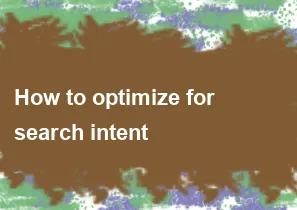How to optimize for search intent

Optimizing for search intent is crucial for improving your website's visibility in search engine results and providing users with relevant content. Here are some tips to help you optimize for search intent:
Understand User Intent:
- Identify the primary intent behind the search query. Intent can be informational, navigational, transactional, or commercial investigation.
- Use tools like Google Analytics, Google Search Console, and keyword research tools to gain insights into user behavior and popular search queries.
Create High-Quality Content:
- Develop content that aligns with the identified search intent. Content should be valuable, informative, and fulfill the user's needs.
- Provide comprehensive answers and solutions to user queries to ensure that your content is relevant and satisfies user intent.
Use Relevant Keywords:
- Integrate target keywords naturally within your content, headings, and meta tags.
- Incorporate variations of your target keywords to capture different facets of user intent.
Optimize Meta Tags:
- Craft compelling meta titles and descriptions that accurately reflect the content's purpose and value.
- Include the primary keywords in your meta tags to signal relevance to search engines.
Improve Page Load Speed:
- Fast-loading pages contribute to a positive user experience. Optimize images, reduce unnecessary scripts, and use caching to improve page speed.
Mobile-Friendly Design:
- Ensure your website is mobile-friendly, as a significant portion of searches occurs on mobile devices. Google considers mobile-friendliness as a ranking factor.
Clear and User-Friendly Structure:
- Organize your content with a clear and user-friendly structure. Use headings, subheadings, and bullet points to break down information.
- Make navigation easy, helping users find what they're looking for quickly.
Include Multimedia Elements:
- Use images, videos, infographics, and other multimedia elements to enhance the user experience and convey information more effectively.
Encourage User Engagement:
- Foster user engagement through comments, social media shares, and other interactive elements on your pages. This can signal to search engines that your content is valuable and relevant.
Monitor and Adjust:
- Regularly review your analytics to assess the performance of your content in terms of search intent.
- Stay updated on industry trends and changes in user behavior to adjust your content strategy accordingly.
By consistently aligning your content and website with user intent, you increase the likelihood of ranking higher in search engine results and providing a positive experience for your audience.
-
Popular Post
- How to optimize for Google's About This Result feature for local businesses
- How to implement multi-language support in an Express.js application
- How to handle and optimize for changes in mobile search behavior
- How to handle CORS in a Node.js application
- How to use Vue.js with a UI framework (e.g., Vuetify, Element UI)
- How to configure Laravel Telescope for monitoring and profiling API requests
- How to create a command-line tool using the Commander.js library in Node.js
- How to implement code splitting in a React.js application
- How to use the AWS SDK for Node.js to interact with various AWS services
- How to use the Node.js Stream API for efficient data processing
- How to implement a cookie parser middleware in Node.js
- How to implement WebSockets for real-time communication in React
-
Latest Post
- How to implement a dynamic form with dynamic field styling based on user input in Next.js
- How to create a custom hook for handling user interactions with the browser's device motion in Next.js
- How to create a custom hook for handling user interactions with the browser's battery status in Next.js
- How to implement a dynamic form with dynamic field visibility based on user input in Next.js
- How to implement a dynamic form with real-time collaboration features in Next.js
- How to create a custom hook for handling user interactions with the browser's media devices in Next.js
- How to use the useSWRInfinite hook for paginating data with a custom loading indicator in Next.js
- How to create a custom hook for handling user interactions with the browser's network status in Next.js
- How to create a custom hook for handling user interactions with the browser's location in Next.js
- How to implement a dynamic form with multi-language support in Next.js
- How to create a custom hook for handling user interactions with the browser's ambient light sensor in Next.js
- How to use the useHover hook for creating interactive image zoom effects in Next.js